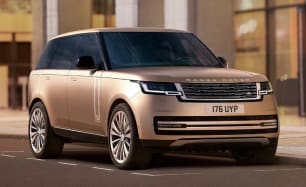Inside, the 2025 Ram 1500 is also updated with a larger 14.4-inch infotainment touchscreen with wireless Apple CarPlay and wired Android Auto, supplemented by a 10.5-inch passenger screen and dual wireless smartphone chargers.
The passenger’s screen is a big deal, too, as it allows the passenger to upload navigation way-points and destinations, watch a movie, or search the internet via a connected phone. And the driver sees none of it thanks to the blackout screen tech.
Even though Ram has obviously gone to a lot of trouble to make the right-hand-drive conversion seamless and perfect, we still wonder why the indicator stalk wasn’t moved to the right of the column. Cost, probably, and the placement of the rotary dial for gear selection is less than perfect, too. What we’d really like to see would be a column-mounted gear-shift, as well as paddle shifters which are brilliant when towing big loads.
The front-seat area is home to no less than three USB-A and three USB-C charging ports, while there are also two of each in the rear seat.
There’s a storage area under the rear seat which also flips up to form a large load area. There’s even a secret cubby-hole under the carpet in the rear capable of storing a laptop or small bag.
In place, the rear seat is another of the Ram’s big selling points compared with conventional dual-cab utes. The foot and leg room is strides ahead of the mid-sized pack and the seat itself is also a better class of perch. The dual-pane panoramic sunroof keeps it all light and airy, too. Plenty of grab handles and those automatic side-steps make getting in and out a pretty civilised process.
Despite the change in engine, the six-cylinder pick-up retains its 4500kg maximum braked towing capacity – at least in Laramie Sport form. That, however, is contingent on the use of a 70mm tow-ball, while towing drops back to 3500kg with the standard 50mm ball. All Aussie Rams have a tow-bar as standard.
The Ram 1500 Limited drops 300kg in its maximum braked towing capacity rating to 4200kg. That, says Ram, is purely because the Limited is a high-performance vehicle first and a load-lugger second, although one suspects the 22-inch Pirelli Scorpion tyres might be a factor in that as well.
As for payload, the 2025 Ram 1500 Laramie Sport features an 863kg capacity, while the Limited comes in at 782.5kg – 20kg and 17.5kg more than the pre-facelift version.
The tub features a spray-on liner and a cargo divider. There’s also a standard tri-fold tonneau cover for Australian 1500s, not to mention a fold-out step for accessing objects at the bottom of the tray. Powered side-steps are also standard on our Rams, backing up the prestige price-tag.
A powered tailgate is another nice inclusion which can be raised and lowered by touch or via the key-fob.
Fortunately, the twin storage bins along the top of each side of the tub remain, complete with their drain holes just perfect for adding ice and cool drinks.

